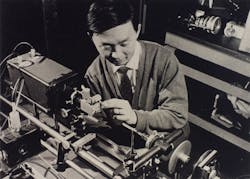Low-loss optical fiber inventor and Nobel laureate Charles Kao dies at 84
Charles Kuen Kao, a Nobel laureate in physics whose research in the 1960s revolutionized the field of fiber optics and helped lay the technical groundwork for the information age, died on Sunday in Hong Kong. He was 84. His death was confirmed by the Hong Kong-based Charles K. Kao Foundation for Alzheimer's Disease, which he and his wife, Gwen Kao, founded in 2010. The foundation declined to specify a cause but said that Dr. Kao learned he had the disease in 2002.
Working in Britain in the late 1960s, Dr. Kao and a colleague played a crucial role in discovering that the fiber-optic cables in use at the time were limited by impurities in their glass. They also outlined the cables' potential capacity for storing information--one that was far superior to that of copper wires or radio waves.
"The word 'visionary' is overused, but I think in the case of Charles Kao, it's entirely appropriate because he really did see a world that was connected, by light, using the medium of optical fiber," said John Dudley, a researcher in fiber optics based in France and a former president of the European Physical Society. "And I think society today owes him a great deal for that work."
In the early 1960s, light pulses carrying telephone and television signals could travel only about 20 meters, or about 65 feet, through glass fibers before nearly all the light dissipated. But by 1970, four years after Dr. Kao and the British engineer George Alfred Hockham published a landmark study on the subject, a group of researchers had produced an ultrapure optical fiber more than a half-mile long.
"It's one of these things where, when you study technology, you start working on one thing, and the impact of it just fans out into all sorts of areas," Dr. Dudley said by telephone. He added that it might have taken decades for Dr. Kao to receive the Nobel Prize because the importance of his work was not apparent to the general public until the 2000s.
Carrie Lam, the chief executive of Hong Kong, a semiautonomous Chinese territory, said in a statement on Sunday that Dr. Kao's work on fiber optics had made a "tremendous contribution to Hong Kong, the world and mankind." She added that he had also played a prominent role in shaping local higher education and scientific research. "An eminent figure, Professor Kao is the pride of Hong Kong people," Ms. Lam said.
Charles Kuen Kao was born in Shanghai on Nov. 4, 1933, to a wealthy family, according to an autobiographical sketch published by the Nobel Foundation. His father, Kao Chun Hsin, was a judge, and his grandfather, Kao Hsieh, had been a Confucian scholar active in a movement to bring down the Qing dynasty during the Chinese Revolution of 1911.
Dr. Kao described his early life in Shanghai as "very pampered and protected." His family moved to Hong Kong when he was 14, on the brink of China's Communist Revolution of 1949, and at 19 he sailed to England to study electrical engineering at Woolwich Polytechnic, now known as the University of Greenwich.
Dr. Kao would later admit that he had not been the most diligent university student. "In those days the degrees were awarded as a First, Second, Pass or Fail," he said. "As I spent more time on the tennis court than with my books, my degree was a Second."
After graduation, he joined a British subsidiary of International Telephone & Telegraph and spent the next three decades working for the company in Britain, Europe, and the United States. It was during his stint in England that he met his future wife, Gwen Wong, a fellow engineer who worked on an upper floor.
In their landmark paper on fiber optics in 1966, "Dielectric-Fiber Surface Waveguides for Optical Frequencies," Dr. Kao and Dr. Hockham noted in their conclusion that "a fiber of glassy material" and certain dimensions "represents a possible practical optical waveguide with important potential as a new form of communication medium."
SOURCE: The New York Times; https://www.nytimes.com/2018/09/24/obituaries/charles-kuen-kao-dead.html

Gail Overton | Senior Editor (2004-2020)
Gail has more than 30 years of engineering, marketing, product management, and editorial experience in the photonics and optical communications industry. Before joining the staff at Laser Focus World in 2004, she held many product management and product marketing roles in the fiber-optics industry, most notably at Hughes (El Segundo, CA), GTE Labs (Waltham, MA), Corning (Corning, NY), Photon Kinetics (Beaverton, OR), and Newport Corporation (Irvine, CA). During her marketing career, Gail published articles in WDM Solutions and Sensors magazine and traveled internationally to conduct product and sales training. Gail received her BS degree in physics, with an emphasis in optics, from San Diego State University in San Diego, CA in May 1986.
